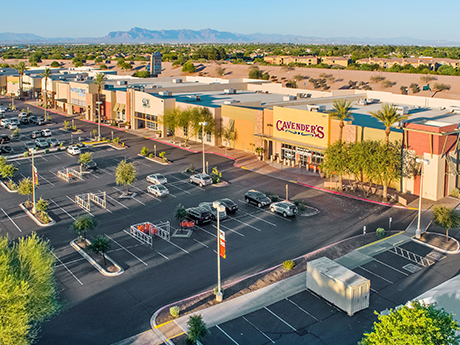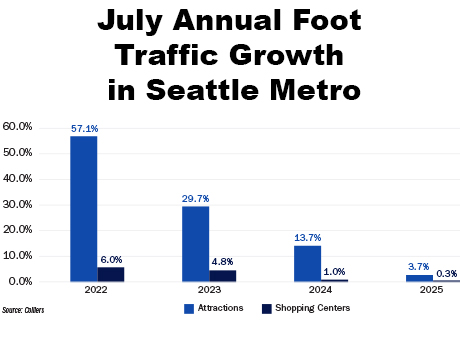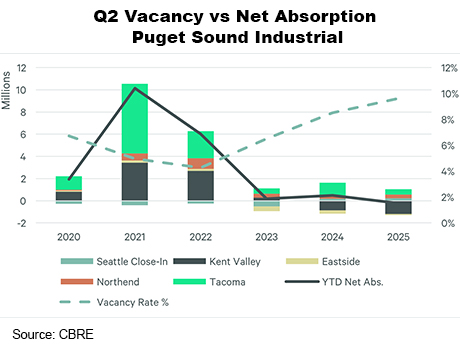— By Bryan Ledbetter of Western Retail Advisors — Phoenix’s retail market continues to surge. Vacancies are dipping below 5 percent, gross absorption is exceeding 1.5 million square feet in the third quarter and asking triple-net rates continue to increase, reaching into the mid-$50 to $60 per square foot range for newly constructed space. West Valley Leads the Charge in New Development After decades of limited retail construction, metro Phoenix — and the West Valley, in particular — are flush with new space. Projects like SimonCRE’s Prasada in Surprise and Vestar’s Verrado in Buckeye are among the major new developments providing the high-end availability that tenants and residents have been asking for. Although elevated debt and construction costs have tempered new development, more than 1.2 million square feet is still under construction. The lion’s share of that product is already pre-leased. This keeps developers and investors bullish on Phoenix, and on the lookout for the Valley’s next development frontier. Though the West Valley reigns as Phoenix’s latest retail boom market, outliers in the East Valley are teeing up for their turn in the spotlight. Apache Junction is a great example… Far Southeast Valley Emerges as a Growth EngineA neighbor of …
Western Market Reports
— By Rick Nelson of Mark IV Capital — The Northern Nevada industrial market continues to stabilize following several years of rapid expansion and then a recalibration driven by broader economic uncertainty. Current conditions have presented challenges, particularly in the logistics and distribution sectors where tariffs and shifting trade policies have created a more cautious investment climate. Fortunately, there are signs of resilience and forward momentum. The region’s vacancy rate stands at 11.7 percent, down from its peak in fourth-quarter 2024, per CBRE. The market also recorded its third consecutive quarter of positive net absorption, with 130,433 square feet absorbed that quarter, bringing the year-to-date total to 1.9 million square feet. Although current construction activity has moderated to 1.6 million square feet currently underway, the development pipeline remains robust, with an additional 15.8 million square feet in planning stages. This underscores sustained investor interest despite elevated vacancy and measured tenant activity. Advanced manufacturing and data centers are poised to be the vanguard of industrial development in the greater Reno area going forward. Cushman & Wakefield recently named Reno No. 5 among emerging data center markets worldwide in its 2025 Global Data Center Market Comparison Report. This recognition reflects the growing …
— By Ben Galles of CBRE — The Reno multifamily market started 2025 with a large supply of new Class A units that was delivered in the fourth quarter of last year. Despite some market challenges, leasing activity of the new supply has gone well, given the limited construction pipeline. There are currently fewer than 700 market-rate units under construction, with very few projects moving forward and starting construction. The constrained development pipeline will likely lead to a significant decrease in vacancy in the second half of 2026 and beyond. This should also start to push rental rates higher, which have been static or slightly down for most of the year, as many owners have offered rent concessions to lock in new tenants. While future market fundamentals are promising, many buyers remained on the sidelines because most deals have been presented at negative leverage. The average price per unit in 2025 (year to date) is down about 22 percent, while the price per square foot is down about 16 percent (year to date) from the previous year. This is due to a few things. First, there was an increase in the number of Class B and C assets that traded …
— By Sam Meredith of Colliers — After a slow and uncertain start to 2025, the retail market in Reno and Sparks is finally finding its stride. The first half of the year saw many tenants hit pause on leasing decisions as economic jitters made retailers cautious. By the third quarter, however, the mood had shifted. Leasing activity picked up noticeably, and tenants are now back in the market, actively looking for space. That momentum is expected to carry through the fourth quarter and into 2026, with healthy absorption on the horizon. This turnaround is backed by solid market indicators. Net absorption turned positive in the second quarter, while asking rents rose quarter over quarter. Vacancies nudged upward due to big-box closures, including three Big Lots and a Joann store early in the year, but the overall retail vacancy still sits at a manageable 5.4 percent. In fact, several submarkets, including North Valleys, Northwest Reno, South Reno and Southwest Reno, are reporting vacancy rates below 2 percent, showing strong demand in key areas. Retailers are clearly taking notice. Trader Joe’s, which once considered Northern Nevada a one-store market, has now opened two additional locations in Spanish Springs and South Reno. …
— By Todd Hamilton of Citywide Commercial Real Estate — The Phoenix industrial market has felt like a game of pause and play over the past 12 months. A year ago, the sector hit pause amid election uncertainty. Post-election hopefulness reignited activity, but tariffs triggered another slowdown. Then came summer, which is always transactionally slow in Phoenix. This pattern was especially pronounced in the mid-size industrial segment, which was dominated by properties with less than 100,000 square feet. Typically owned by mom-and-pop investors or regional players, these groups lack institutional backing and are more sensitive to factors like interest rates, rising product costs and recession chatter. Despite the unpredictability, Phoenix industrial space has maintained its trademark resilience. Rents grew 4.7 percent year over year, per CoStar’s latest market report, while 787 sales were completed in the past 12 months, at an average price of $180 per square foot. Large-scale inventory (buildings 400,000 square feet and above) has also enjoyed a recent resurgence. At the start of the year, we were wringing our hands over multiple vacant, million-plus-square-foot buildings. Since then, five of those buildings have been leased or sold, with full occupancy expected by year-end. That activity accounts for a …
— By Jason Price of Commercial Properties Inc./CORFAC International — The Phoenix office market continues to show balance as leasing patterns shift and tenants prioritize smaller footprints. The metro’s office inventory totals 195.5 million square feet across roughly 9,000 buildings. Construction has edged upward year over year, with a little more than 900,000 square feet currently underway compared with 844,000 square feet a year ago. Another 1.5 million square feet is expected to deliver between 2025 and 2026, a restrained pace that should help prevent oversupply. This discipline has become critical as companies continue to right-size and lenders remain cautious. The overall market faces slower demand for large contiguous blocks, limited financing availability and an elevated level of sublease inventory that will take time to absorb. Most of the sublease space consists of second-generation Class A and B product in downtown and the Camelback Corridor, where tenants are evaluating long-term space requirements before recommitting. Even so, Phoenix’s fundamentals remain relatively healthy compared with many other metros. The city’s diversified economy, steady population inflow and expanding employment base continue to support leasing activity, particularly for move-in-ready suites of less than 10,000 square feet. Small-business confidence and the return-to-office movement among local …
— By Jacob Pavlik of Colliers — As big-box retailers scale back or exit the market, a new class of tenants is reshaping the retail landscape across the Puget Sound region. Experiential retail is taking their space and providing destinations for consumers and the experiences they crave. This umbrella term includes concepts that prioritize interaction, entertainment and social connection. This is emerging as a compelling solution for landlords looking to drive foot traffic and re-energize shopping centers. The shift is not accidental. The pandemic disrupted traditional social experiences and accelerated the decline of large-format retail by getting people more accustomed to buying online, even if they “picked up” the item later in a store. Now, with consumers eager to reconnect in person, experiential concepts have gained traction. These tenants often don’t sell goods or services in the conventional sense. Instead, they offer immersive experiences that encourage group participation and repeat visits. Recent examples include Mirra, a 12,000-square-foot social entertainment venue that opened in Bellevue’s Lincoln Square, a mixed-use shopping center with three hotels, and more than 1.2 million square feet of office space. Adjacent to Cinemark Reserve in the South Tower, Mirra offers immersive virtual reality party games and transitions to …
— By Andrew Hitchcock of CBRE — The Puget Sound industrial market is showing signs of modest recovery through the first half of 2025. Tenants are increasingly seeking flexible leases, renewing in place and right-sizing operations, resulting in smaller or more cautious leasing commitments rather than long-term deals. Shifts in port activity have also affected leasing decisions, exacerbated by the raft of universal tariff announcements in April. While some submarkets have regained momentum after a slow start, demand across the region is still uneven, with lingering uncertainty keeping vacancy rates elevated. Submarkets demonstrating momentum include Tacoma, which recorded 308,153 square feet of positive net absorption in the second quarter, alongside notable third-party logistics provider (3PL) leasing activity. The Seattle Close-In area also saw vacancy decrease to 9.3 percent, driven by healthy tenant demand from companies like Evergreen Goodwill and South West Plumbing. Conversely, Kent Valley faced challenges. The vacancy rate climbed to 8.4 percent due to significant speculative deliveries that outpaced absorption and traditional users downsizing. Port activity temporarily dampened demand, compounded by a 21.2 percent year-over-year drop in international imports in May. This reflects uncertainty surrounding future tariff rates. On the plus side, year-to-date container volumes remain above 2024 …
— By Dan Dahl of Kidder Matthews — Seattle’s office market has proven more resilient than other cities in past downturns, with smaller declines and quicker recoveries. This cycle is different. Seattle has been hit harder and is recovering more slowly than the rest of the country. San Francisco often signals what’s to come, with the Emerald City trailing by about 12 months. AI-driven leasing activity in San Francisco is gaining momentum — signaling growth for Seattle — but the local market still faces headwinds. Demand Softens as Tenants Downsize Demand for office space in Seattle remains weak. Most tenants with upcoming lease expirations are downsizing. Tech companies have historically driven office demand here, but now they are shedding space, laying off employees and working from home. Tenants have the leverage. Concessions like free rent, reduced rates and built-out spaces are abundant, providing the opportunity for tenants to pursue a flight to quality and upgrade to higher-end space. Investment Market Under Pressure The investment side is equally challenged. Owners with near-term loan expirations are often in a pinch. Their loan balances exceed current building values due to high vacancies, lower rental rates, elevated cap rates and higher interest rates. As a …
— Tim McKay of Cushman & Wakefield — Seattle’s multifamily market has faced challenges over the past few years. Rent growth has been flat as a significant number of new units were delivered in 2023 and 2024. This new supply also led to concessions and even rent declines in some markets. Submarket supply issues and the new statewide rent control legislation have also contributed to market headwinds. However, 2025 has brought signs of recovery, and there’s optimism about the market’s trajectory over the next few years. It feels like Seattle has bounced off the bottom and is starting to climb back up, similar to the recovery seen in 2011 after the Global Financial Crisis. Rebounding Demand The multifamily market has seen a recent uptick in demand, which can be attributed to several factors. A key driver has been the return-to-office mandates from major employers like Amazon and Starbucks. Seattle’s population is also expected to grow again, and the supply of new units hitting the market has drastically declined. These factors are contributing to renewed growth after a four- to five-year stagnation. Stabilizing Rental Rates Owners are starting to put properties under contract again. Land prices haven’t returned to previous levels, …
Newer Posts




